geo.wikisort.org - River
The Dordogne (French pronunciation: [dɔʁdɔɲ] (![]() listen); Occitan: Dordonha) is a river in south-central and southwest France. It is 483.1 km (300.2 mi) long.[1] The Dordogne and its watershed were designated Biosphere Reserve by UNESCO on July 11 2012.[2]
listen); Occitan: Dordonha) is a river in south-central and southwest France. It is 483.1 km (300.2 mi) long.[1] The Dordogne and its watershed were designated Biosphere Reserve by UNESCO on July 11 2012.[2]
This article may be expanded with text translated from the corresponding article in French. (July 2014) Click [show] for important translation instructions.
|
This article needs additional citations for verification. (August 2017) |
| Dordogne | |
|---|---|
 The Dordogne in Périgord, near Castelnaud-la-Chapelle | |
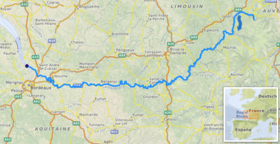 Location of the Dordogne in France | |
| Location | |
| Country | France |
| Physical characteristics | |
| Source | |
| • location | Massif Central |
| • elevation | 1,720 m (5,640 ft) |
| Mouth | |
• location | Gironde estuary |
• coordinates | 45°2′29″N 0°36′24″W |
| Length | 483 km (300 mi) |
| Basin size | 23,870 km2 (9,220 sq mi) |
| Discharge | |
| • average | 450 m3/s (16,000 cu ft/s) |
| Basin features | |
| Progression | Gironde estuary→ Atlantic Ocean |
Geography
The river rises on the flanks of the Puy de Sancy at 1,885 metres (6,184 ft) above sea level in the mountains of Auvergne, from the confluence of two small torrents above the town of Le Mont-Dore: the Dore and the Dogne. It flows generally west about 500 kilometres (310 mi) through the Limousin and Périgord regions before flowing into the Gironde, its common estuary with the Garonne, at the Bec d'Ambès ("Ambès beak"), north of the city of Bordeaux.
Nature

The Dordogne is one of the few rivers in the world that exhibit the phenomenon of a tidal bore, known as a mascaret.[3]
The upper valley of the Dordogne is a series of deep gorges. The cliffs, steep banks, fast flowing water and high bridges attract both walkers and drivers. In several places the river is dammed to form long, deep lakes. Camp sites and holiday homes have proliferated wherever the valley floor is wide enough to accommodate them.
Below Argentat and around Beaulieu-sur-Dordogne, the valley widens to accommodate fertile farmland, well-watered pasture and orchards. In the towns, which are major tourist attractions because of their history and architecture, the quaysides are lined with eating and drinking places. In Périgord, the valley widens further to encompass one of France's main gastronomic regions, with vineyards, poultry farms and truffle-rich woodlands.
The main season for tourism in the Valley of the Dordogne is from June to September, with July and August being high season. The lifestyle and culture of the Dordogne valley attract both visitors and incomers from all over France, but also from many other countries, particularly Britain and Germany.
Course
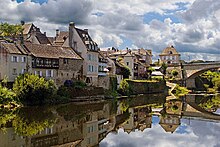
The départements of France through which the Dordogne runs, together with some towns in those départements that are on or quite near the river, are as follows:
- The département of Puy-de-Dôme – The towns of Le Mont-Dore (near the source of the river) and La Bourboule;
- The département of Corrèze – The towns of Argentat, Bort-les-Orgues, and Beaulieu-sur-Dordogne;
- The département of Lot – The towns of Souillac, Pinsac, Lacave, Meyronne, Creysse, Montvalent, Martel, Floirac, Carennac, Gintrac, Tauriac and Prudhomat;
- The département of Dordogne – The towns of Beynac-et-Cazenac, Sarlat, Saint-Cyprien, and Bergerac;
- The département of Gironde – The towns of Sainte-Foy-la-Grande and Libourne.
Tributaries
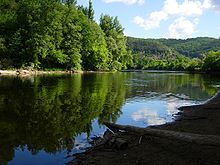
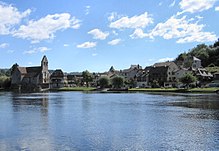

Main tributaries from source to mouth:[1]
N.B. : (R) = right tributary; (L) = left tributary
Activities
Aside from the usual activities such as tennis and golf available in many areas of France, there are a number of water-related activities related to the Dordogne, including:
- Fishing, an age-old pastime for the locals and for visitors;
- Canoeing and kayaking, very popular (canoes & kayaks are easy to rent);
- Boating in a Gabare (a traditional skiff peculiar to the Dordogne);
- Rafting;
- Swimming;
- Motorboating;
- Sailing;
- Rowing and sculling;
- Water skiing.
Dams
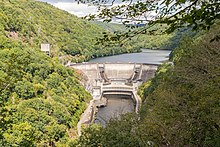
- Marèges Dam
- Dam at Bort-les-Orgues
- Barrage de l'Aigle (The Eagle Dam)
- Dam at Argentat
- Dam at Bergerac
- Dam at Chastang
- Dam at Mauzac
- Barrage de Tuilières
References
External links
- The Dordogne Valley in the Lot department (website in French)
- The Dordogne Valley UNESCO Biosphere Reserve (website in French)
На других языках
[de] Dordogne
Die Dordogne [.mw-parser-output .IPA a{text-decoration:none}dɔʀˈdɔɲ] (okzitanisch Dordonha) ist ein Fluss im Südwesten Frankreichs. Sie entsteht im Gemeindegebiet von Mont-Dore, in der Nähe des Puy de Sancy, aus dem Zusammenfluss der Quellbäche Dore und Dogne. Generell entwässert sie in westlicher Richtung, trifft nach einem Flussverlauf von rund 483[2] Kilometern beim Bec d’Ambès, nahe Bordeaux, mit der Garonne zusammen und bildet so einen Mündungstrichter, der unter dem Namen Gironde schließlich in den Atlantischen Ozean mündet. Am 11. Juli 2012 wurde das gesamte Einzugsgebiet der Dordogne als Biosphärenreservat von der UNESCO klassifiziert[3].- [en] Dordogne (river)
[es] Río Dordoña
El río Dordoña (Dordogne en francés; Dordonha en occitano) es un río del suroeste de Francia que nace en Auvernia a 1680 metros de altura en Puy de Sancy (lo Puèi de Sancí en occitano). Tiene 483,3 kilómetros de longitud. Es navegable en 117 km de su curso. Su régimen es pluvio-nival. El 11 de julio de 2012, el río Dordoña así como el conjunto de la cuenca fueron designados por la Unesco como Reserva de Biosfera.[1][it] Dordogna (fiume)
La Dordogna (in francese Dordogne) è un fiume del sud-ovest della Francia.[ru] Дордонь (река)
Дордо́нь (фр. Dordogne, окс. Dordonha, лат. Duranius, Dordonia) — река на юге Франции. Река берёт исток в горах Центрального массива у вершины Санси возле курортного городка Мон-Дора, протекает около пятисот километров по регионам Франции, и к северу от Бордо впадает в Гаронну, образуя вместе эстуарий Жиронду. Это одна из немногих рек, у которой происходят приливы и отливы. Длина реки — 472 км.[1]. Среднегодовой расход воды — 274 м³/с[2]. Высота истока — более 1700 м над уровнем моря. Долина Дордони чрезвычайно живописна и привлекательна для посетителей, поэтому в этом районе развита индустрия туризма.Другой контент может иметь иную лицензию. Перед использованием материалов сайта WikiSort.org внимательно изучите правила лицензирования конкретных элементов наполнения сайта.
WikiSort.org - проект по пересортировке и дополнению контента Википедии